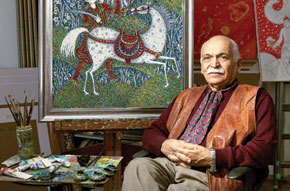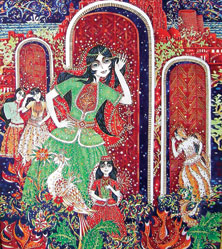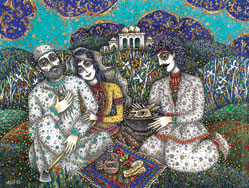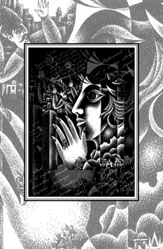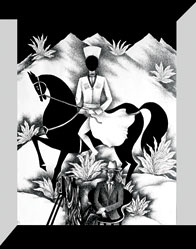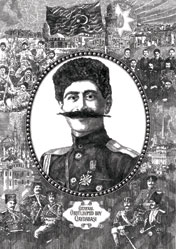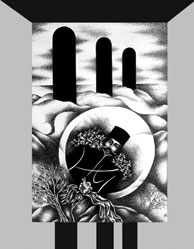The career of People’s Artist Arif Huseynov spans over 40 eventful years in the history of Azerbaijani art. The 1960s and 70s, when he was just starting out, marked a turning point in the visual arts in Azerbaijan. We can only imagine the atmosphere of criticism when his first paintings were exhibited. Maybe it’s because of this demanding milieu that they still look fresh and modern today.
As a young artist, Arif Huseynov began collaboration with the popular children's magazine Goyerchin (Dove). His illustrations in Goyerchin, which had hundreds of thousands of readers across the country, reached a far wider audience than pictures at exhibitions, which were visited by a few hundred art lovers in Baku. Arif Huseynov developed as an artist at Goyerchin, with whom he continued his collaboration for many years, eventually becoming the magazine’s art director.
Local artists were Arif’s teachers in secondary school and college in Baku, and helped to shape his creative understanding of national literary and artistic heritage. Arif’s mature work gives his own figurative expression to ancient national traditions. His first drawings were characterised by an epic quality of expression. This was succeeded by greater use of symbolism and wider stylisation. In his more recent period, he has given a modern aspect to the artistic style of ancient miniatures. This article looks back at the artist’s work from the vantage point of his 70th birthday, which he celebrated this year.
Baku and Bakuvians series
Arif Huseynov’s series Baku and Bakuvians is an expression of the artist’s love for his home city. The diverse range of images, created using different techniques, is immediately striking. Old Bakuvians is a dominant picture in the series. Using mixed techniques, the artist depicts two old intellectuals in the Old City. The walled Old City “emerges” from a dark black surround to occupy the centre of the picture. Though the artist’s use of light and shadow differs from the classical Western approach, his sincere “artistic lies” and exaggeration are very convincing.
Another picture in the series – Photo Studio (Retro) – picks at the scab on the wound of nostalgia of the older generation. It shows a man on horseback, dressed in national costume, against the background of a pleasant “false” view. A photographer waiting for the next customer can be seen in the lower part of the vertical composition. The work can even be considered a historical source, a record of the popularity of such photographer’s studios. Other works of note in the series include Old City, Portrait of the Artist Alakbar Rzaquliyev and First Teacher. The artist's ability to wonder at his surroundings and depict them in memorable and effective lines can be seen in other series too, such as Oil Rocks, Fencers and Badminton Players.
Baikal-Amur Mainline series
Construction of the Baikal-Amur railway (BAM) across permafrost and through virgin forest in eastern Siberia was a spectacular project in the Soviet Union in the 1970s and 80s. This mammoth venture required labour, which could be obtained only through challenging the young people of the Soviet Union to play their part in construction. Well-known figures from the worlds of culture and the arts, as well as young artists, were regularly sent to the BAM site. In 1976, Arif Huseynov was one of three Azerbaijani artists, alongside Arif Azizov and Oleg Ibrahimov, to be sent to BAM. They returned full of impressions of what Leonid Brezhnev dubbed the Construction Project of the Century. In 1977, the resulting exhibition in Baku showed the impact of the trip on the young artists. The creative optimism of the giant construction project can be felt in works such as Young Azerbaijanis at BAM, Road Builders, Dreams Come True and Cutting down the Forest, all using the tricky monotype technique. Arif Huseynov also painted dozens of portraits, including Rovshan, Fighter and Sabutay.
Palette of Friendship series
The Palette of Friendship series was the result of the artist’s trip to what was then Czechoslovakia in 1981, together with artist Fikret Hashimov. The works exhibited a year later in the city of Uherske Hradiste are a rich reflection of the artist’s observations. They include Welcome, Joseph!, Violinist from Moravia and Holiday in Prague.
Home Village – Qala series
Arif Huseynov is originally from the village of Qala, one of the oldest places in Absheron. His love for his home is evident in the nostalgia of the paintings in this series. He brings to life his childhood experiences, including the older residents of Qala. The painting Old People (mixed technique) is a fine example of Arif Huseynov’s skill and individuality. The artist’s use of line intervals and the compactness of the painting are especially effective. Again deliberately breaking the laws of light and shadow, he achieves a rhythmical expressiveness in the composition. As the old people are illuminated, “emerging from” darkness, the lines disappear into the sandy, cloudy Absheron landscape. This is particularly striking. There are many touching artistic and aesthetic aspects, such as the way that the old man holds his stick and the old woman clasps a rooster to her chest.
The portraits of Bayali and Haji Mahrali, figures of historical importance in the village, are realistic, but go beyond the bounds of narrow realism. The fine lines in the oval portraits, beginning with the face and finishing with their clothing, are very precise. The depictions of scenes from Absheron and Qala around the portraits add to their overall impact.
Novruz series
Arif Huseynov’s Novruz series marked a radical departure from the common approach to the subject in Azerbaijani art. His depictions of the much-loved folk ceremonies and customs of the Novruz spring holiday can be seen as a new, creative reworking of the ancient Azerbaijani traditions of miniature painting. The viewer cannot help but be infected by the festive spirit in the wide-range of subjects, such as Azerbaijani Mugham, Pomegranate Festival and Eavesdropping to Learn Her Fate (according to tradition, if a girls listens at a closed door at Novruz, the first man’s name that she hears is the name of her future husband).
Portrait “patchwork”
Portraits of contemporary and historic figures and literary characters constitute a rich seam in Arif Huseynov’s work. The images of poets Nizami, Fizuli and Sabir, authors Tolstoy and Hans Andersen or of Azerbaijani generals depict accurately the physical characteristics of their subjects, but also penetrate their inner world. The subjects are united with the places where they lived and the artistic images created by them, enabling the viewer to look afresh at the familiar subjects.
Hohhopnameh
Arif Huseynov is the only modern Azerbaijani illustrator to have taken a consistent interest in the work of Mirza Alakbar Sabir. In 1980, when the artist had yet to make his name, he won the commission to illustrate a new edition of Sabir’s Hophopnameh for Yazichi publishing house. The recommendation of eminent artist Mikayil Abdullayev played its part in Arif’s success. His illustrations caused a storm at the time. The public were used to looking at Azim Azimzadeh’s pictures when they read Sabir’s poems and suddenly they found the black and white illustrations of the young artist. The thought-provoking images showed that the Hophopnameh could be read in other ways, complementing the ideas of the poet.
Arif Huseynov produced a new design and 40 new illustrations for an edition of the Hophopnameh published to mark the 150th anniversary of Sabir’s birth in 2012. These images are seen as a successful synthesis of the poet’s and the artist’s views. Created using mixed techniques, the illustrations have inner and outer compositions. Contrast is stronger for the central compositions and weaker for the outer ones, continuing the tension from the written word to the image and focusing attention on the central composition. The artist uses three main components in his illustrations – an informative setting, a depiction of the subject and lines of poetry. The artist used the three alphabets for the lines of poetry in which the Hophopnameh has been published in Azerbaijani (Arabic, Cyrillic and Latin). Plates such as Mamdali Flirting in Europe and Love of Money are fine examples of modern illustration.
Fairy-tale world
Arif Huseynov has created modern images for the fairy tales that have enchanted Azerbaijani children and adults down the ages. He combined tradition and modernity in his designs for the book Fairy Tales of Azerbaijan, which is published in English. Forty illustrations to 28 tales convey through symbolism and metaphor the artist’s figurative understanding of the world of fairy tales. Grounded in the rich traditions of the ancient art of miniatures, Arif Huseynov was able to convey the weight of meaning in his illustrations. They combine the real and the unreal, mirage and fairy tale. The images, that bear the literary heritage of centuries, are not always understood immediately and test the viewer. For example, the pomegranate that hides its beauty inside, the legendary fish rising out of the water or the white horse that comes to people’s aid in times of trouble. Sunrise and sunset and other visual elements are symbols, carriers of meaning, used logically by the artist in his compositions. Some of the best examples of this are the illustrations for tales such as Lazy Ahmad, Shengulum, Shungulum, Mengulum or Malikmammad.
Artistic view of literature
In his designs and illustrations for numerous books by local and foreign authors, Arif Huseynov gives a modern interpretation to traditional Azerbaijani principles. The illustrations are not a simple depiction of what the artist has read, but his view of them through the prism of time. Going beyond the bounds of simple illustrations, the images open a broad expanse for the readers, making the artist one of the rightful authors of the book. Some of the best examples are Arif Huseynov’s illustrations for Fitna by Nizami Ganjavi, Lyrics by Samed Vurgun, The Knight in the Tiger Skin by Shota Rustaveli and Dr Aybolit by Korney Chukovsky.
Arif Huseynov is familiar with the history and artistic traditions of book illustration in east and west, which resulted in the creation of very different works. The artist prefers to convey the essence and nature of characters, using symbolism and other devices, rather than give a straightforward external depiction. In this way, he has created attractive and thought-provoking images of key literary characters. This stimulates the reader-viewer’s perception and has a clear impact on the interaction between works and their readers.
Challenging the viewer
Laconicism, expression and rhythm can be seen in all Arif Huseynov’s work, not just his illustrations. Using different techniques, he conveys to the viewer generalised themes, stories and types. His effective use of association, light and shadow both create a romantic mood and challenge the viewer to think. The “talkativeness” of his perceptible line intervals is another example of the artist’s skill.
Arif Huseynov’s graphic interpretation of people and objects, civilisation and nature, time and memory as well as of many problematic issues, and his combination of tradition and modernity keep his work fresh and make it interesting for both local and foreign art lovers.
